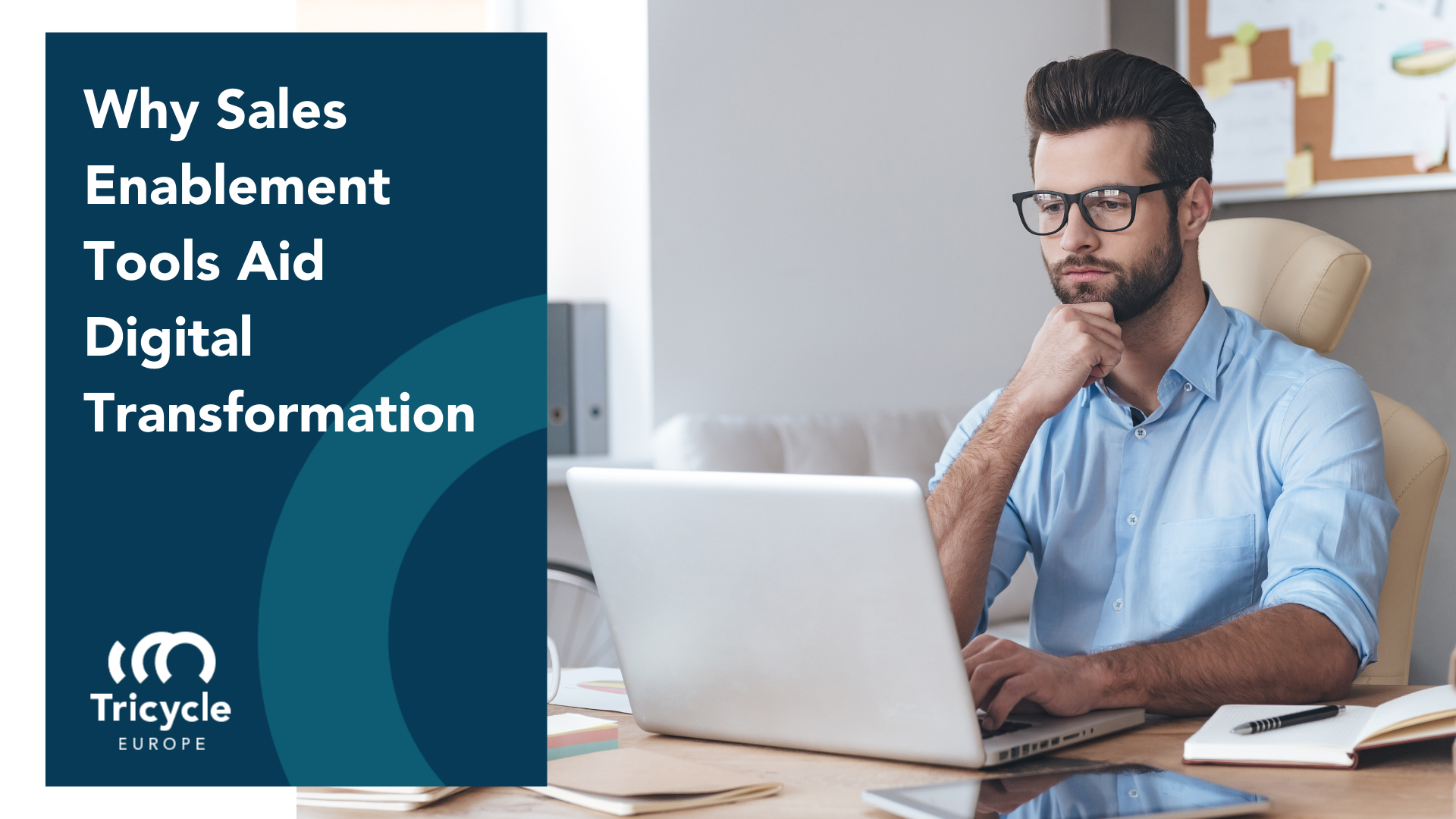Digital transformation is not taking work away from people. It’s actually creating more opportunities to align sales and marketing goals as well as leverage tools to their full potential. What are sales enablement tools? These tools have a variety of functions. They can help you research your target prospects, monitor them on the buyer’s journey, engage with them on LinkedIn, recommend next steps, and conduct social listening for more relevant engagement.
Before sales enablement tools were an industry-standard, companies had much higher customer acquisition costs. People went out into the field to pitch face-to-face in hopes that prospects would grasp the blanketed problem-solution fit. Sales productivity was lower as the lead’s progress had to be tracked manually, a highly fragmented process with information gaps across the company.
A key issue with this method was the lack of information flow between sales and marketing departments. While marketing people ensured that prospects were getting the right content in front of their eyes, salespeople helped them to see the problem-solution fit. If these departments weren’t connected, the buyer’s journey could be bumpy and inconsistent.
The disconnected approach is not only very expensive but doesn’t consider unique needs. Companies have always needed a mix of services to succeed. Additionally, every lead needs to be treated as an individual to truly understand their pain points. It has never been one-size-fits-all.
The best salespeople during the pre-internet era were good at engaging in conversation. The best salespeople now? They are good listeners, creative thinkers, and researchers that can leverage all of their resources to create maximum impact.
Why Do Sales Enablement Tools Impact How We Engage Customers Today?
Sales prospecting tools are one of the many digitals tools that help us qualify leads. Each company has its own set of criteria to measure how likely the lead is to buy.
Prior to the digital transformation, Sales Enablement Leaders didn’t truly exist. We sent people out into the field to make a canned pitch to businesses, used endless cold-calling to warm up and qualify leads, all without the sales management tools that are available today.
Now, Sales Enablement Leaders serve as the missing link between sales and marketing departments. Both the tools and their actions need to act collaboratively to ensure we’re staging the buyer’s learning process and aligning goals with results. The right tools, when not used correctly, can underdeliver, and the wrong tools can be holding you back.
One popular way to qualify and interact with leads is LinkedIn and LinkedIn Sales Navigator. This “social selling” approach is a result of the digital transformation and sharp sales and marketing people realizing the power of social media in the workplace.
Digital Transformation and Sales Enablement
The dawn of the internet era opened sales teams to a wealth of information about any organization they wanted to learn more about. The early days were via websites, but now social media profiles have a wealth of information available. This transparency meant a number of things:
- Salespeople were making a lot fewer cold calls since they could glean information from websites and online trade publications.
- Sales productivity tools, although rudimentary at the time, were saving countless hours of administrative work.
- Sales productivity metrics could be quickly measured for individuals, teams, and the company as a whole.
- Salespeople could align with marketing insights to tweak their pitch based on consumer trends.
While these shifts moved the world forward, many sales teams are still under-utilizing their resources. There is now a wealth of internal and external tools that can provide real-time insights on prospects. However, many salespeople are still not having the right conversations or properly qualifying the decision-makers. This is pulling either the wrong people or not enough through the digital buyer’s journey.
Sales Enablement Leaders are the connection between sales and marketing departments. Marketers strategize and write the content, and salespeople share it with their audience, whether it’s for a single lead or many. It’s a fixed collaboration that results in making calculated decisions that ensure the strategy leads to results.
Why Are Sale Enablement Tools So Important?
Sales enablement tools are an umbrella of tools born out of digital transformation. There are sales automation tools, CRM tools, and even AI-powered sales tools. Why do we often have more than one? If we’re lucky, the company we’re working for is subscribed to a full-service suite that handles every aspect of the process to ensure optimal productivity.
Executing successful projects depends on aligning sales goals with marketing strategy. It’s symbiotic. Adopting the right tools, understanding the benefits, and, most importantly, teaching our teams how to leverage them is key to long-term success.
First and foremost, your CRM is the beating heart of sales enablement. This houses all the key details on each lead and current client. Sales CRM tools ensure that we always pick up where we left off with clients and also make it easier to transition accounts to new hires in the least amount of time.
LinkedIn Sales Navigator has become an integral piece of the modern digital selling journey. Sales Enablement leaders can strategize how to link existing tools to outreach on LinkedIn for maximum impact. Sales Navigator helps automate some of the more tedious processes and feed data into your CRM to keep leaders and team members in sync.
Sales automation doesn’t have to be a dirty word. It’s not a robot overlord or a cookie-cutter approach to talking to leads. In fact, sales automation tools ensure that sales teams spend less time on admin work and more time interacting with clients. These tools log email details, record call synopses, and handle various processes that were once manual. The newfound free time can be used to coach and train new hires and work on business development.
Are Sales Enablement Platforms Used to Their Full Potential?
They aren’t. To give an example, LinkedIn Sales Navigator allows paid subscribers to save lists of prospects, use advanced filtering, and integrate their findings within the company’s CRM. Many users are still doing this process manually every time they log in, echoing the bygone era of sales professionals being overloaded with admin work.
Other tools such as Prospect.io will even provide email templates for drip campaigns and measure success in a standardized report. How much time have you spent in the past year creating drip campaigns from scratch and reviewing a bunch of fragmented reports? If your answer is too much time, you’re underutilizing your sales enablement platform’s capabilities.
The best sales tools allow teams to optimize and automate parts of the sales funnel. For example, if we can bulk email a group of leads and then set up triggers for clicks and opens, we’ve already saved ourselves a lot of time. Instead of going back to check and manually handling the next phase, our email software handles it for us and generates a report.
Sales Productivity Tools and Your Long-Term Vision
The best sales productivity tools work together seamlessly and do the heavy lifting for you, not the other way around. One of the main benefits of digital transformation is how much data we can gather and sort in the least amount of time. (Cue LinkedIn Sales Navigator and your CRM.)
Knowing more about a spread of customers all at once enables clearer forecasting and goal tracking. In a matter of minutes, Sales Enablement Leaders can tally progress towards short and long-term goals. The information is no longer fragmented but available to all.
This benefit also comes with great responsibility. Digital transformation frameworks are meant to help propel companies forward – offering solutions, not spinning a fit to only benefit the seller.
The COVID-19 pandemic has forced many companies to finally build an online presence. As salespeople, it’s totally unfair to exploit this to sell organizations into a solution that isn’t scalable.
The digital divide is not the only area where we need to exercise responsibility. As salespeople, we need to act carefully if we uncover sensitive information that could impact a seller for the better. Similar to how when we know a defendant is guilty, but we can’t present the damning evidence right out of the gate. We must instead build a relationship with the lead and let them share once they’re comfortable. It doesn’t matter if you already know.
Ready to dive deeper into which tools can fuel your digital transformation and how? Read our next piece on How Choosing The Right Sales Enablement Tools Ensures Your Success.





